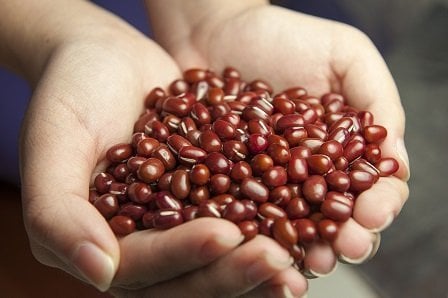
Making Sense of Nutrition and Resistant Starch
It’s time for another expert Featured Post. Once again this expert – Kusha Karvandi – has been seen on the site several times before but we wanted him back for a full-length article! This piece covers an interesting; nutrition topic – resistant starch – that we all probably need to learn a little more about! So sit back and enjoy this highly actionable and informative article!
Resistant Starch Breakdown
The body always breaks down starch into simple sugars such as glucose but not all starch is easily broken down.
There are other types of starch that the body is unable to break down completely but converts to short-chain fatty acids. The intestinal bacteria usually act on these resistant starches, in a way that is really good for your health.
Why is Some Starch Resistant?
Starch is basically a composition of two main polysaccharides (meaning many sugars) namely amylopectin and amylose. The latter is structured with a straight-chain which limits the resultant surface area for digestion whereas the former has a highly branched structure giving it an optimal surface area for digestion.
Amylopectin can cause a rise in insulin and blood sugar levels due to its ease of digestion. Similarly, amylose takes much more time to get digested and therefore lowering the risk of high blood sugar and insulin spike
The Amylose
The resistant starch, or simply RS, is actually amylose. Your body attempts to digest it, especially in the small intestine, in an effort to break it down to glucose. Unfortunately, amylose is not easily broken down and therefore tends to resist the digestion process.
This resistance allows RS to safely reach the large intestine or colon where fermentation takes place with the aid of intestinal bacteria. Note that not all fiber, especially fiber supplements which are basically made from wood chips, are processed like RS in the body.
Most fiber supplements are actually very abrasive on the digestive tract and can kill good bacteria.
The RS and Short-Chain Fatty Acids (SCFAs)
While RS is not fully digested, this does not necessarily mean that your body does not require any of this. In fact, the fermentation at the colon results in the formation of SCFAs which may be absorbed back into the body.
In some cases, the colonic bacteria may reserve some of the fats for energy supply. The benefits of SCFAs include the following:
● Helps in the circulation of nutrients
● May excite blood flow especially to the colon
● Improves mineral absorption in the body
● Prevents absorption of toxic compounds
● Impedes pathogenic bacterial growth

The amount of carbohydrates that you consume determines the total amount of SCFAs in your body. It is also important to note that the rate of absorption is proportional to the rate of digestion.
This makes RS a better choice for staying lean and healthy.
A research study carried out on foods reveals that refined foods provide more caloric energy than whole foods.
This means that the number of calories that the body obtains from whole grains may be less than the total amount of calories it actually contains. The ordinary starch can provide up to 4 calories per gram as compared to roughly 2 calories per gram supplied by RS.
This follows that resistant starch foods can fill you up easily without necessarily filling you out.
Modern processed foods have reduced the net amount of resistant starch such as potato fries in place of boiled potatoes, burgers rather than beans, and cereal bars instead of oats.
You should keep in mind that psyllium, methylcellulose and wheat bran have entirely different benefits. This means that the only way to reap the full benefits of RS is to include whole food in your daily diet.
Unlike developing countries where people take in a lot of wholesome foods containing RS of up to 30-40 grams/day, the United States, Europe, New Zealand, Australia and other developed countries consume much of the processed foods that can merely contain 3-9 grams of RS on a daily basis.
Resistant starch has several benefits including:
Improved Blood Fats
The beneficially fatty acids produced by RS greatly reduces the risk of heart-related complications. RS can also help suppress fat cell production, though this observation has been recorded only in rats.
The resulting fats from the RS digestion increase the level of fats that are used for energy production.
Better Satiety
Peptide YY, glucagon, and leptin are important hormones that drastically reduce your craving for food, thanks to the SCFA triggers.
RS is therefore responsible for better satiety, though it may take up to a year for these hormones to adapt. The appetite is stabilized by the slow absorption of nutrients into the blood.
Insulin Sensitivity
Insulin is maintained at lower and safer levels due to less sugar production from digestion. The insulin response is also increased especially in balancing the influx between fat cells and muscles.
Improved Digestion
One of the major conditions that are associated with digestion is the Irritable Bowel Syndrome (IBS) which can easily be eliminated by taking the right amount of RS. Other conditions that can also be alleviated by RS include constipation, diverticulitis, and even ulcerative colitis.
The colon is also responsible for the absorption of vital minerals such as calcium, though this process may sometimes be inhibited by abnormal colonic bacteria. However, the SCFAs prevent the production of such bacteria.
Better Body Composition
High amounts of RS might cause a thermic effect in the body which may be beneficial for fat loss. Moderate amounts can help your body composition as well because the overall energy content of RS is lower than other starches.
Hydration
At times the body might lose a significant amount of water due to conditions such as diarrhea or cholera. In such cases, the consumption of RS can help the body retain more water. This is because RS normalizes bowel functions.
Improves Immunity
The body’s immunity can be improved by consuming a significant amount of resistant starch which enhances the production of anti-inflammatory compounds at the same time helping in producing immune cells, especially in the gut.
Where to Find Resistant Starch
Resistant starch can be found naturally in typical foods such as:
● Starchy fruits like bananas and vegetables
● Legumes such as beans
● Whole grains
● Cooked potatoes and rice
Note that overcooked foods reduce the amount of RS with an exception of Type 3 RS.
Amount of Resistant Starch to Consume
 According to research, approximately 40-45 grams of RS is recommended to be consumed on a daily basis.
According to research, approximately 40-45 grams of RS is recommended to be consumed on a daily basis.
This means that exceeding the above amount could result in secondary effects such as bloating and diarrhea due to uncontrolled functionalities of the colonic bacteria especially fermentation.
On the other hand, the response to RS may vary from one person to another as well as the type of RS which can either be RS1, RS2, RS3 or RS4.
But in most cases, RS fermentation abilities are not timeless and therefore the body can adapt over time.
Conditions for RS Tolerance
● When RS is taken as solid instead of liquid
● When consumed with other meals
● When RS is gradually consumed instead of taken at once
Wrap-Up
Your body absorbs more energy through well-cooked, refined, and processed carbs.
This means that leaving the machines to perform the better part of digestion will leave you with extremely digestible carbs, and likely a daily caloric surplus (not good for weight loss). This scenario is unhealthy and destabilizes insulin hormone and blood sugar levels in the body.
Other cultures tend to be leaner because they consume intact grains, starchy fruits and vegetables, and unprocessed legumes. This observation is highly attributed to resistant starch.
If you could consume 6-12 grams of RS per day or most appropriately 20 grams, then your chances of being lean and healthy will be significantly higher.
Note that taking too much resistant starch, mostly over 40 grams per day may result in complications related to digestion. The problem might be escalated if the food taken was industrially processed. The best source of resistant starch is always from natural and whole food sources.
However, the benefits of resistant starch may vary from one person to another, you have to always consider yourself and your unique biology an experiment of one.
- Blood Flow Restriction Training 101 - December 14, 2015
- Resistant Starch: Why Is It So Good For You? - March 31, 2015


